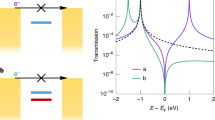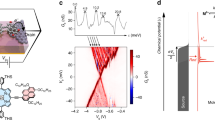Abstract
Molecular electronics aims at exploiting the internal structure and electronic orbitals of molecules to construct functional building blocks1. To date, however, the overwhelming majority of experimentally realized single-molecule junctions can be described as single quantum dots, where transport is mainly determined by the alignment of the molecular orbital levels with respect to the Fermi energies of the electrodes2 and the electronic coupling with those electrodes3,4. Particularly appealing exceptions include molecules in which two moieties are twisted with respect to each other5,6 and molecules in which quantum interference effects are possible7,8. Here, we report the experimental observation of pronounced negative differential conductance in the current–voltage characteristics of a single molecule in break junctions. The molecule of interest consists of two conjugated arms, connected by a non-conjugated segment, resulting in two coupled sites. A voltage applied across the molecule pulls the energy of the sites apart, suppressing resonant transport through the molecule and causing the current to decrease. A generic theoretical model based on a two-site molecular orbital structure captures the experimental findings well, as confirmed by density functional theory with non-equilibrium Green's functions calculations that include the effect of the bias. Our results point towards a conductance mechanism mediated by the intrinsic molecular orbitals alignment of the molecule.
This is a preview of subscription content, access via your institution
Access options
Subscribe to this journal
Receive 12 print issues and online access
$259.00 per year
only $21.58 per issue
Buy this article
- Purchase on Springer Link
- Instant access to full article PDF
Prices may be subject to local taxes which are calculated during checkout




Similar content being viewed by others
References
Aviram, A. & Ratner, M. A. Molecular rectifiers. Chem. Phys. Lett. 29, 277–283 (1974).
Moth-Poulsen, K. & Bjornholm, T. Molecular electronics with single molecules in solid-state devices. Nature Nanotech. 4, 551–556 (2009).
Quek, S. Y. et al. Mechanically controlled binary conductance switching of a single-molecule junction. Nature Nanotech. 4, 230–234 (2009).
Diez-Perez, I. et al. Controlling single-molecule conductance through lateral coupling of π-orbitals. Nature Nanotech. 6, 226–231 (2011).
Venkataraman, L., Klare, J. E., Nuckolls, C., Hybertsen, M. S. & Steigerwald, M. L. Dependence of single-molecule junction conductance on molecular conformation. Nature 442, 904–907 (2006).
Mishchenko, A. et al. Influence of conformation on conductance of biphenyl-dithiol single-molecule contacts. Nano Lett. 10, 156–163 (2010).
Guedon, C. M. et al. Observation of quantum interference in molecular charge transport. Nature Nanotech. 7, 304–308 (2012).
Vazquez, H. et al. Probing the conductance superposition law in single-molecule circuits with parallel paths. Nature Nanotech. 7, 663–667 (2012).
Xue, Y. et al. Negative differential resistance in the scanning-tunneling spectroscopy of organic molecules. Phys. Rev. B 59, R7852–R7855 (1999).
Guisinger, N. P., Greene, M. E., Basu, R., Baluch, A. S. & Hersam, M. C. Room temperature negative differential resistance through individual organic molecules on silicon surfaces. Nano Lett. 4, 55–59 (2004).
Heersche, H. B. et al. Electron transport through single Mn12 molecular magnets. Phys. Rev. Lett. 96, 206801 (2006).
Tu, X., Mikaelian, G. & Ho, W. Controlling single-molecule negative differential resistance in a double-barrier tunnel junction. Phys. Rev. Lett. 100, 126807 (2008).
Gaudioso, J., Lauhon, L. J. & Ho, W. Vibrationally mediated negative differential resistance in a single molecule. Phys. Rev. Lett. 85, 1918–1921 (2000).
Kratochvilova, I. et al. Room temperature negative differential resistance in molecular nanowires. J. Mater. Chem. 12, 2927–2930 (2002).
Mentovich, E. D. et al. Multipeak negative-differential-resistance molecular device. Small 4, 55–58 (2008).
He, J. & Lindsay, S. On the mechanism of negative differential resistance in ferrocenylundecanethiol self-assembled monolayers. J. Am. Chem. Soc. 127, 11932–11933 (2005).
Chen, J., Reed, M. A., Rawlett, A. M. & Tour, J. M. Large on–off ratios and negative differential resistance in a molecular electronic device. Science 286, 1550–1552 (1999).
Chen, J. et al. Negative differential resistance effect in organic devices based on an anthracene derivative. Appl. Phys. Lett. 89, 083514 (2006).
Fracasso, D., Valkenier, H., Hummelen, J. C., Solomon, G. C. & Chiechi, R. C. Evidence for quantum interference in SAMs of arylethynylene thiolates in tunneling junctions with eutectic Ga-In (eGaIn) top-contacts. J. Am. Chem. Soc. 133, 9556–9563 (2011).
Van Ruitenbeek, J. M. et al. Adjustable nanofabricated atomic size contacts. Rev. Sci. Instrum. 67, 108–111 (1996).
Kergueris, C. et al. Electron transport through a metal–molecule–metal junction. Phys. Rev. B 59, 12505–12513 (1999).
Simmons, J. G. Generalized formula for electric tunnel effect between similar electrodes separated by a thin insulting film. J. Appl. Phys. 34, 1793 (1963).
Perrin, M. L. et al. Large tunable image-charge effects in single-molecule junctions. Nature Nanotech. 8, 282–287 (2013).
Hong, W. et al. An MCBJ case study: the influence of π-conjugation on the single-molecule conductance at a solid/liquid interface. Beilstein J. Nanotechnol. 2, 699–713 (2011).
Te Velde, G. et al. Chemistry with ADF. J. Comput. Chem. 22, 931–967 (2001).
Fonseca Guerra, C., Snijders, J. G., te Velde, G. & Baerends, E. J. Towards an order-N DFT method. Theor. Chem. Acc. 99, 391–403 (1998).
Kaliginedi, V. et al. Correlations between molecular structure and single-junction conductance: a case study with oligo(phenylene-ethynylene)-type wires. J. Am. Chem. Soc. 134, 5262–5275 (2012).
Valkenier, H. et al. Cross-conjugation and quantum interference: a general correlation? Phys. Chem. Chem. Phys. 16, 653–662 (2013).
Cornil, J., Karzazi, Y. & Bredas, J. Negative differential resistance in phenylene ethynylene oligomers. J. Am. Chem. Soc. 124, 3516–3517 (2002).
Liu, R., Ke, S-H., Baranger, H. U. & Yang, W. Negative differential resistance and hysteresis through an organometallic molecule from molecular-level crossing. J. Am. Chem. Soc. 128, 6274 (2006).
Verzijl, C. J. O. & Thijssen, J. M. DFT-based molecular transport implementation in ADF/BAND. J. Chem. Phys. C 116, 24393–24412 (2012).
Loertscher, E. et al. Transport properties of a single-molecule diode. ACS Nano 6, 4931–4939 (2012).
Batra, A. et al. Tuning rectification in single-molecular diodes. Nano Lett. 13, 6233–6237 (2013).
Acknowledgements
This research was carried out with financial support from the Dutch Foundation for Fundamental Research on Matter (FOM), NWO/OCW, FP7-framework programme ELFOS, ERC grant no. 240299 and by an ERC advanced grant (Mols@Mols). The authors thank C. Verzijl for help with DFT calculations.
Author information
Authors and Affiliations
Contributions
D.D. and H.v.d.Z. designed the project. M.P. fabricated the devices. H.V. and J.H. designed and provided the molecules. M.P. and M.K. performed the low-temperature I–V series without electrode fusion. M.P. and R.F. performed the low-temperature I–V breaking series. R.F. performed the room-temperature I–V breaking series. M.P., J.S., J.C.G. and J.T. performed the DFT + NEGF calculations. N.R. and F.G. performed the molecular dynamics simulations. M.P., J.S., J.T. and H.v.d.Z. wrote the manuscript. All authors contributed to the interpretation of the data and commented on the manuscript.
Corresponding author
Ethics declarations
Competing interests
The authors declare no competing financial interests.
Supplementary information
Supplementary information
Supplementary Information (PDF 7803 kb)
Rights and permissions
About this article
Cite this article
Perrin, M., Frisenda, R., Koole, M. et al. Large negative differential conductance in single-molecule break junctions. Nature Nanotech 9, 830–834 (2014). https://doi.org/10.1038/nnano.2014.177
Received:
Accepted:
Published:
Issue Date:
DOI: https://doi.org/10.1038/nnano.2014.177
This article is cited by
-
Computational study of transition metal dichalcogenide cold source MOSFETs with sub-60 mV per decade and negative differential resistance effect
npj 2D Materials and Applications (2022)
-
Dynamic molecular switches with hysteretic negative differential conductance emulating synaptic behaviour
Nature Materials (2022)
-
Controllable potential barrier for multiple negative-differential-transconductance and its application to multi-valued logic computing
npj 2D Materials and Applications (2021)
-
A transverse tunnelling field-effect transistor made from a van der Waals heterostructure
Nature Electronics (2020)
-
Tuning the charge flow between Marcus regimes in an organic thin-film device
Nature Communications (2019)



